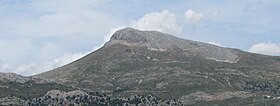Subbaetic System
| Subbaetic System | |
|---|---|
| Sistema Subbético | |

Peña de la Cruz, the highest peak in the Sierra Arana
|
|
| Highest point | |
| Peak | Peña de la Cruz |
| Elevation | 2,027 m (6,650 ft) |
| Dimensions | |
| Length | 510 km (320 mi) ENE/WSW |
| Width | 60 km (37 mi) NNW/SSE |
| Geography | |
| Location | Andalusia / Murcia |
| Country | Spain |
| Range coordinates | 37°33′0″N 3°22′0″W / 37.55000°N 3.36667°WCoordinates: 37°33′0″N 3°22′0″W / 37.55000°N 3.36667°W |
| Parent range | Baetic System |
| Geology | |
| Orogeny | Alpine orogeny |
| Age of rock | Cenozoic |
| Type of rock | Limestone |
The Subbaetic or Sub-Baetic System (Spanish: Sistema Subbético or Cordillera Subbética) is one of the three systems of mountain ranges of the Baetic System in the southern Iberian Peninsula. Highest point 2,027 m (6,650 ft) high Peña de la Cruz in Sierra Arana. Its northern limit includes the valley of the Guadalquivir in its western part.
The Subbaetic System runs to the north of the Cordillera Penibética from Cape Trafalgar in Cádiz Province across Andalusia reaching into the Region of Murcia. The highest peaks reach heights between 1,500m and well over 2,000 m.
Towards the east of the Sierra Sur de Jaén, east of Martos, another subsystem begins, the Prebaetic System, an offshoot of the Subbaetic System stretching further northeastwards. The materials that compose this eastern sector were formed in a relatively shallow sea.
Some of the mountain ranges that make up the Subbaetic System are, from west to east:
...
Wikipedia

